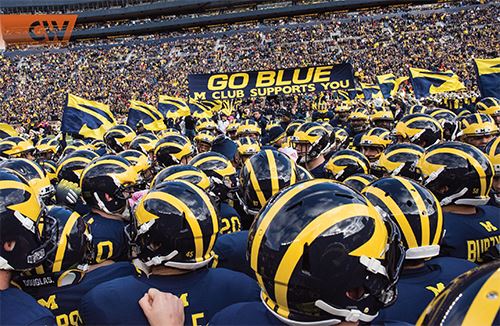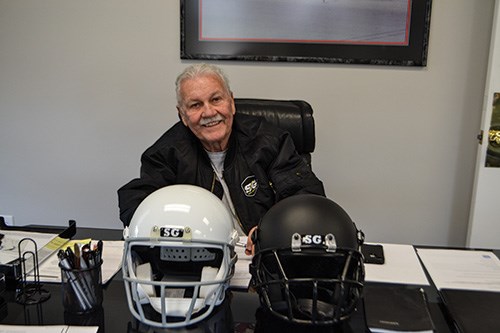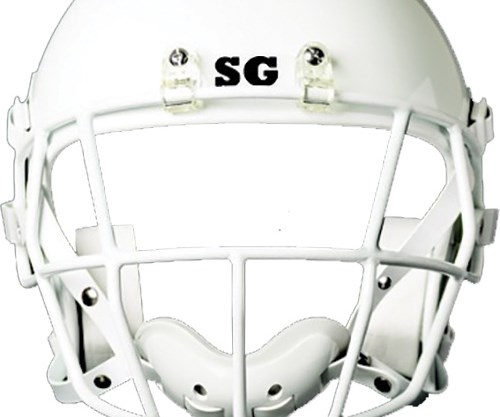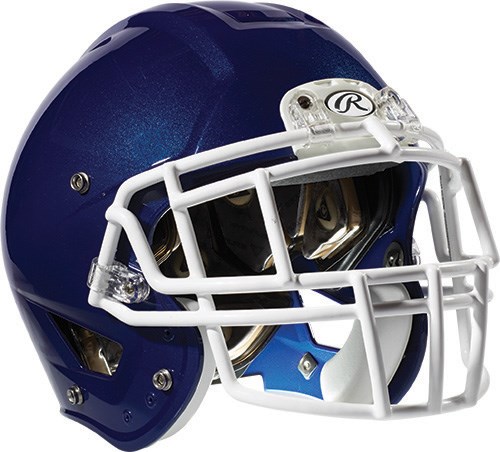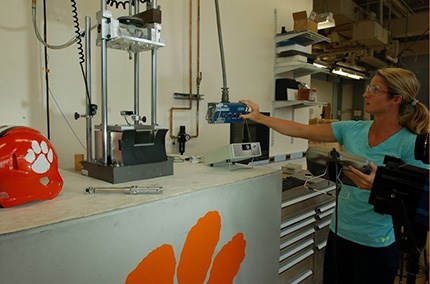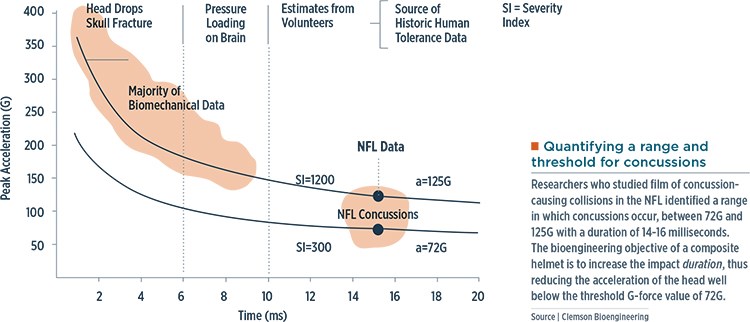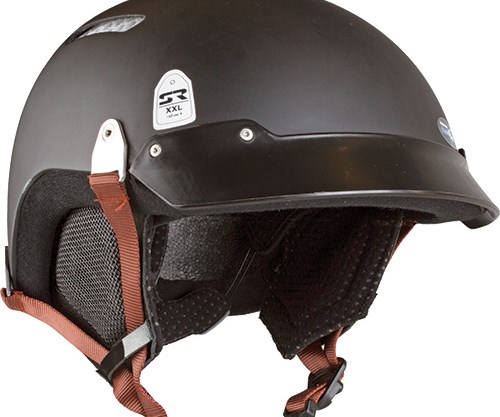Composites tackle concussions
The launch of the first commercial composite football helmet and new research thrusts show FRPs could play a critical role in mitigating head injuries.
Share
It has become a familiar scene on Saturday and Sunday afternoons during the American football season: A lightning-fast play, a helmet-to-helmet hit and a player laid out, semi-conscious on the ground.
For many years, of course, composites have been incorporated into headgear and helmets used in military, industrial and recreational sports activities, such as those for skiing and whitewater kayaking. Composites also have recently moved into headgear used in wide-participation, mainstream sports: In 2013 Major League Baseball (MLB) and the MLB Players Assn. adopted the Rawlings Sporting Goods Co.’s (St. Louis, MO, US) S100 Pro Comp batting helmet, constructed of aerospace-grade carbon fiber composite, as the league standard. Rawlings says the helmet is 300% stiffer and 130 times stronger than the conventional ABS helmet it replaced, while providing enhanced protection for ball strikes of up to 100 mph.
Yet, despite being a sport that involves physical contact on every play, and despite growing alarm about the frequency and severity of head injuries, American football teams almost exclusively equip their players with a helmet consisting of a polycarbonate (PC) exterior shell with an interior lining of foam padding — a basic design that has gone unchanged for more than 30 years. “The innovation in football helmet design has basically been with respect to the interior padding and facemask, and very little to the shell,” says Elizabeth Cates, VP of R&D at Innegra Technologies (Greenville, SC, US).
Given the increasing role composites have and are playing in headgear and helmets of all types, it was only a matter of time before someone attempted to build a fiber-reinforced composite football helmet. That distinction fell to SG Helmets (Brownsburg, IN, US), the manufacturer of the SG helmet, introduced to the market in 2012. Short for Simpson and Ganassi (i.e., former race car drivers Bill and Chip), the SG is made of Kevlar aramid fiber (from DuPont Protection Solutions, Richmond, VA, US), carbon fiber and epoxy. Bill Simpson, the primary point person in the endeavor, spent 1.5 years on R&D and another 1.5 years on field testing. Testing was conducted at Purdue University (Lafayette, IN, US) where researchers found the SG helmet was at least 50% better at dissipating forces to the head than the traditional PC helmet. One of the key benefits of the helmet is that it is about half the weight of its predecessors (~0.91 kg).
After some initial product-launch issues, which included defects such as cracking, the SG is getting noticed in a market known for its conservatism: 40 to 50 players in the National Football League (NFL) have adopted the helmet, a metric that is noteworthy not only because of the short time the helmet has been on the market but also because the SG is targeted to youth league football, at the high school level and below, where one of the greatest benefits afforded by the switch to composites is the lighter weight of the shell. The weight reduction meshes well with the body sizes of the hundreds of thousands of kids playing pee-wee, Pop Warner and high school football, many of whom are wearing ABS/PC helmets built for people three times their size. “I’m not trying to sell to the NFL. My interest is in the kids,” says Simpson. (And the numbers indicate that’s also good business. See the Side Story titled “Football participation tops in high school” under "Editor's Picks") Toward that end, SG Helmets reports that several high schools and youth leagues in Indiana have adopted the SG.
Notably, the SG was recently given a five-star rating, based on a safety and performance testing and rating system devised by the bioengineering department at Virginia Polytechnic Institute and State University (Virginia Tech, Blacksburg, VA, US). Researchers at the school took more than a decade’s worth of head/helmet acceleration data collected on Virginia Tech football players and mapped it to a laboratory test system that collects more than 120 points of impact test data on each helmet, measuring its ability to absorb energy and reduce head acceleration. Results of the rating system, called the Virginia Tech Helmet Ratings, are posted at www.sbes.vt.edu/helmet.php. Thus far, the program has tested 26 commercial football helmets, 25 made with polycarbonate or ABS shells, and the composite-shelled SG Simpson.
Along with its five-star rating, however, the SG’s posted result was accompanied by several warnings, including one about cracking in the internal padding — not the composite — and a caution to consumers about a stated lifetime for the SG of two years, when the expected lifetime of a PC helmet is typically 10 years. SG Helmets president Bill Simpson takes issue with both. “We built the first prototype of the helmet in 2010, and since that time we have continually been tinkering with the formula and the manufacturing process,” he says, reporting the helmets are hand-layed, bagged and oven-cured at 140°C. “Cracking is not an issue for the current model.” As for the two-year stated lifetime, Simpson says when SG Helmets started the helmet certification process with the National Operating Committee on Standards for Athletic Equipment (NOCSAE), he was required to give an expected lifespan and simply stated “two” without a clear understanding of the football helmet market or certification process. “Our helmet’s expected lifespan,” he says,” is 10 years like every other helmet on the market.”
The physics of concussions: The brain/shell interface
It’s important to note that helmet design, here, is complicated by the fact that American football is, above all, a contact sport. Stefan Duma, the director of Virginia Tech’s School of Biomedical Engineering and Sciences, says two major factors determine a helmet’s performance and rating. “The highest-rated helmets,” Duma says, “protect against high-impact hits, but they also protect against medium- to low-impact collisions, which players experience much more often.” It’s not just about the Big Hit.
This “duality” related to the helmet shell’s protective capabilities, the material impact resistance and toughness necessary to provide 10-year durability, and the need to compete on price point (the SG is about 20% more expensive than other top-rated brands), make designing and manufacturing a composite football helmet for mass-market use a challenging undertaking.
Innegra’s Cates says her company was inspired recently to take a fresh, blank-slate approach to the challenge after seeing a “concussion simulator” developed by bio-engineering researchers at Clemson University (Clemson, SC, US) for the Roper Mountain Science Center in Greenville, SC. It consisted of a test dummy’s head and upper torso, similar to the type used in Karate training. An accelerometer mounted in the head monitored the G-forces upon receiving a blow from a member of the audience, with a display screen indicating if a concussion threshold was reached.
“When we saw the Clemson exhibit demonstrating the forces associated with head injuries,” says Cates, “we naturally thought of the hot-button issue related to football and concussions.” Innegra already supplies its Innegra S and H fibers to customers who manufacture helmets for whitewater kayaking and other extreme sports that present the potential for impacts equal to or greater than those in football, so it seemed plausible to Cates and her team that these same materials could provide benefits in the design of a football helmet. Soon thereafter, Innegra and Shelby, NC, US-based fiberglass supplier B & W Fiberglass (already a partner/supplier in the production of the Innegra H fiber), approached Clemson’s bio-engineering department about the possibility of a partnership in a study to evaluate the properties and performance of composite materials and their suitability for a potential application in the outer shell of a football helmet.
The first phase of the project, a materials characterization study, was completed in 2014. About 25 materials were tested to ASTM D7136-12 “Standard Test Method for Measuring the Damage Resistance of a Fiber-Reinforced Polymer Matrix Composite to a Drop-Weight Impact Event.” The basic test setup comprised a drop sled system called a “cushion tester,” a high-speed camera and an analysis computer. A flat panel sample coupon of each material of interest is placed into a fixture at the base of the drop sled where it is subjected to impact by an object of a specified weight and shape. Sensors measure velocity of impact and sample displacement, while a high-speed camera records rebound velocity and contact time. These values, in turn, are used to calculate the impact coefficient of restitution and energy absorption. These are the key parameters for materials intended for use in applications subject to multiple and continual impacts. They provided the study with a baseline distinction between the various samples.
The initial materials tested were, by design, simple, consisting of a single reinforcement material and an off-the-shelf epoxy. Fibers tested included various types of glass and carbon as well as Innegra’s olefin-based S-fiber, and also the company’s H-fiber, a hybrid yarn, consisting of its S fiber combined with another high-modulus fiber, such as carbon, S-glass or basalt. “We deliberately tested simple systems because we wanted to specifically focus on fiber behavior in this phase,” says Cates. Included in the initial round of testing were control flat-panel samples of neat PC and ABS. Although the project entailed evaluating elementary composite structures, the early findings are reportedly promising, pointing to significant differences in the performance of composites with respect to both controls.
“We’ve seen some remarkable results thus far with the various fibers we’ve tested, indicating composites could provide superior protection against the types of impacts and forces generated in football,” says John DesJardins, who is the Hambright Leadership associate professor of bio-engineering at Clemson. DesJardins, who is collaborating closely on this project with Dr. Greg Batt, Clemson’s assistant professor of Food and Packaging Science, notes that polycarbonate has high impact resistance but is not very good in terms of energy dissipation. This property makes both PC and ABS good at withstanding repeated impacts without breaking, but not so good at mitigating concussion-causing forces.
The design solution for energy dissipation has been to pad the interior of the shell with copious amounts of foam. Until now, the possibility that the shell could be a front line of defense against head injuries in football has been constrained by the notion that its first, and foremost, function is impact resistance. “We knew from high-energy impact applications, such as ballistics, that fiber-reinforced composites provide great advantages in dissipating forces laterally, rather than directly through the material,” says Cates.
The second phase of testing, commencing this year, will evaluate a more complex set of fiber and resin laminate systems and layups, including toughened resin systems and different combinations of commingled yarns (Innegra’s H-fiber) and woven fabrics. It also will employ a slightly modified test method that uses an impactor with a larger radius and geometry designed to more closely mimic the curvature of a football helmet. Desjardins reports that the same drop sled used in the first phase also will be used in the next, although the drop height will be lower due to the greater mass of the impactor.
Although basic fiber-reinforced materials demonstrated some significant potential performance enhancements with respect to the control materials in the first phase of testing, researchers expect the use of a wider impactor in the next round to change some of the energy dissipation characteristics. In short, “everything is on the table” on the materials side of the equation, says Cates. Further, she notes that greater cognizance of manufacturing cost and processing factors will be necessary as the project moves forward.
Helmet optimization: The performance/cost interface
That is a bridge already crossed by Shred Ready (Auburn, AL, US), a manufacturer of helmets and safety gear for whitewater paddlers. The company currently makes five all-composite whitewater helmet models, as well as less-expensive helmets made of injection molded ABS. One of the most common layups for a number of its composite models comprises two layers of glass on the inside ply and a layer of Kevlar as the outside ply. Shred Ready president and founder Tom Sherburne says the aramid fiber layer provides excellent energy dissipation properties, and enhances design features. “Composites, and in particular Kevlar, allows us to design a more form-fitting helmet and get the same impact absorption as a traditional injection molded ABS,” he claims, reporting that comparable interior foam padding for a helmet with an ABS shell needs to be 3-4 mm thicker.
Shred Ready also has launched a new model this year called the OSK, for Old School Kool. The helmet features a shell made entirely of composites, reinforced with fibers supplied by Innegra. Manufactured “under high heat and pressure,” the shell sports three inner layers of Innegra-S and an outer layer of Innegra-H carbon hybrid fiber. Sherburne says the hybrid fiber processes better than the purely hydrophobic olefin fiber and provides a better surface finish — important, because decorative details are applied to the helmet, post-cure.
“The Innegra S fiber is equal to Kevlar for impact absorption, and the carbon adds toughness,” Sherburne contends, noting an overall gain in cost-effectiveness, compared to other material solutions.
A similar construction, involving either or both of the Innegra fibers, might be the “X-factor” in the design and manufacture of a football helmet that could meet all the necessary performance criteria and narrow the price premium between it and football helmets made of polycarbonate.
Success in building a next-generation football helmet will no doubt hinge on a similar amount of tweaking and trade-offs. In a study introducing a new head injury metric, called “the combined probability of concussion,” Steve Rowson, research assistant professor, bio-medical engineering, Virginia Tech, writes, “part of the remaining burden of reducing concussion incidence relies on improvement of head protection,” noting current football helmets are designed to prevent skull fractures, not to guard against concussion. “One of the challenges in designing helmets to account for concussive forces is accurately modeling concussion risk,” he writes.
One of the original studies attempting to quantify the threshold forces associated with concussions was carried out by researchers at Wayne State University (Detroit, MI, US) in the 1960s (Gurdjian, ES, et. al.). This and subsequent studies have focused on concussions as a function of two factors: Impact magnitude (acceleration measured in G-force) and impact duration (in milliseconds or ms). Research has identified a range in which for concussion-producing impacts occur in the NFL: between 72G and 125G, with a duration of 14-16 ms. From this quantitative angle, the goal of a composite helmet would be to increase the duration of impact, thus dissipating some of the energy laterally, thereby decreasing the resulting acceleration and G-force to a value substantially below the threshold value of 72G (see the chart at left).
But such a helmet must be able to withstand repeated impacts through the course of a game and season, and therein lies the rub. “When you look at the market for helmets, composites are widely accepted for motorcycles, bike racing, whitewater sports,” Cates says. But she points out: “What distinguishes a motorcycle helmet from a football helmet is if you crash and damage your motorcycle helmet, you replace it.” The standard a successful football helmet design must meet in the final phase of testing is to sustain more than 1,000 impacts, yet retain all its functional, protective characteristics. This, she says, implies a fundamental difference in the way one designs materials and develops a helmet.
The final phase of the Clemson-based research project will consist of testing full helmets attached to a dummy head to a standard established by NOCSAE, Doc (ND) 001-11m13, “Standard Test Method and Equipment Used in Evaluating the Performance of Protective Headgear/Equipment.” The researchers at Clemson will be building a new tower and drop carriage. In order for a helmet to pass the test, it must be able to withstand impact at an acceptable level, according to NOCSAE’s Severity Index (SI) — a pass/fail threshold value for a helmet’s ability to reduce impact force calculated in terms of acceleration and duration in 16 helmet locations. It also must meet all other damage and durability requirements of the specification.
When development reaches this stage, the project team will need a helmet manufacturing partner, says Cates, and efforts are ongoing to secure one. Further, the research could have broader long-term commercial benefits. “We’re sponsoring this research focused on helmets in contact sports, but impact is really a much wider issue in the composites world,” she acknowledges. “So, in this sense, we’re looking at this as a basis to understand impact better, more generally, and to allow us to make more nuanced materials suggestions and solutions to our customers.”
A helmet on every at-risk head
First into the market, the SG helmet has proven the mettle of composites as a superior material for dissipating G-forces related to football head-to-head collisions and concussions. As with any new product, ongoing R&D efforts will fine-tune and enhance early designs, and address the realities of commercial cost in a highly competitive market. As the process plays out, prompting greater emphasis on safety in American football, delivering fundamental research insights with spin-off benefits for other applications in which head injuries are a risk, it promises to be a win-win for helmet manufacturers, football players of all ages and the parents and fans who cheer them on.
Related Content
Sulapac introduces Sulapac Flow 1.7 to replace PLA, ABS and PP in FDM, FGF
Available as filament and granules for extrusion, new wood composite matches properties yet is compostable, eliminates microplastics and reduces carbon footprint.
Read MoreThe potential for thermoplastic composite nacelles
Collins Aerospace draws on global team, decades of experience to demonstrate large, curved AFP and welded structures for the next generation of aircraft.
Read MoreMcLaren celebrates 10 years of the McLaren P1 hybrid hypercar
Lightweight carbon fiber construction, Formula 1-inspired aerodynamics and high-performance hybrid powertrain technologies hallmark this hybrid vehicle, serve as a springboard for new race cars.
Read MoreNatural fiber composites: Growing to fit sustainability needs
Led by global and industry-wide sustainability goals, commercial interest in flax and hemp fiber-reinforced composites grows into higher-performance, higher-volume applications.
Read MoreRead Next
Developing bonded composite repair for ships, offshore units
Bureau Veritas and industry partners issue guidelines and pave the way for certification via StrengthBond Offshore project.
Read More
